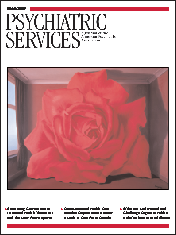Management of Hepatitis C Disease Among VA Patients With Schizophrenia and Substance Use Disorders
Abstract
OBJECTIVE: Rates of hepatitis C (HCV) infection, testing, and treatment were compared among patients with schizophrenia, a substance use disorder, or co-occurring schizophrenia or schizoaffective disorder and a substance use disorder and a control group. METHODS: Information about 293,445 patients of the Northwest Veterans Healthcare Administration was obtained. RESULTS: The substance use disorder group constituted 13.6 percent of the sample; the schizophrenia group, 1.6 percent; and the co-occurring-disorders group, 1.4 percent. Respectively, these groups were approximately four, two, and six times as likely as the control group to receive HCV testing and about seven, two, and eight times as likely to be infected. The rate of interferon (IFN) therapy was significantly lower for the substance use group and the group with co-occurring disorders. However, the magnitude of the differences was not substantial, suggesting that these high-risk groups were not excluded from IFN therapy.



